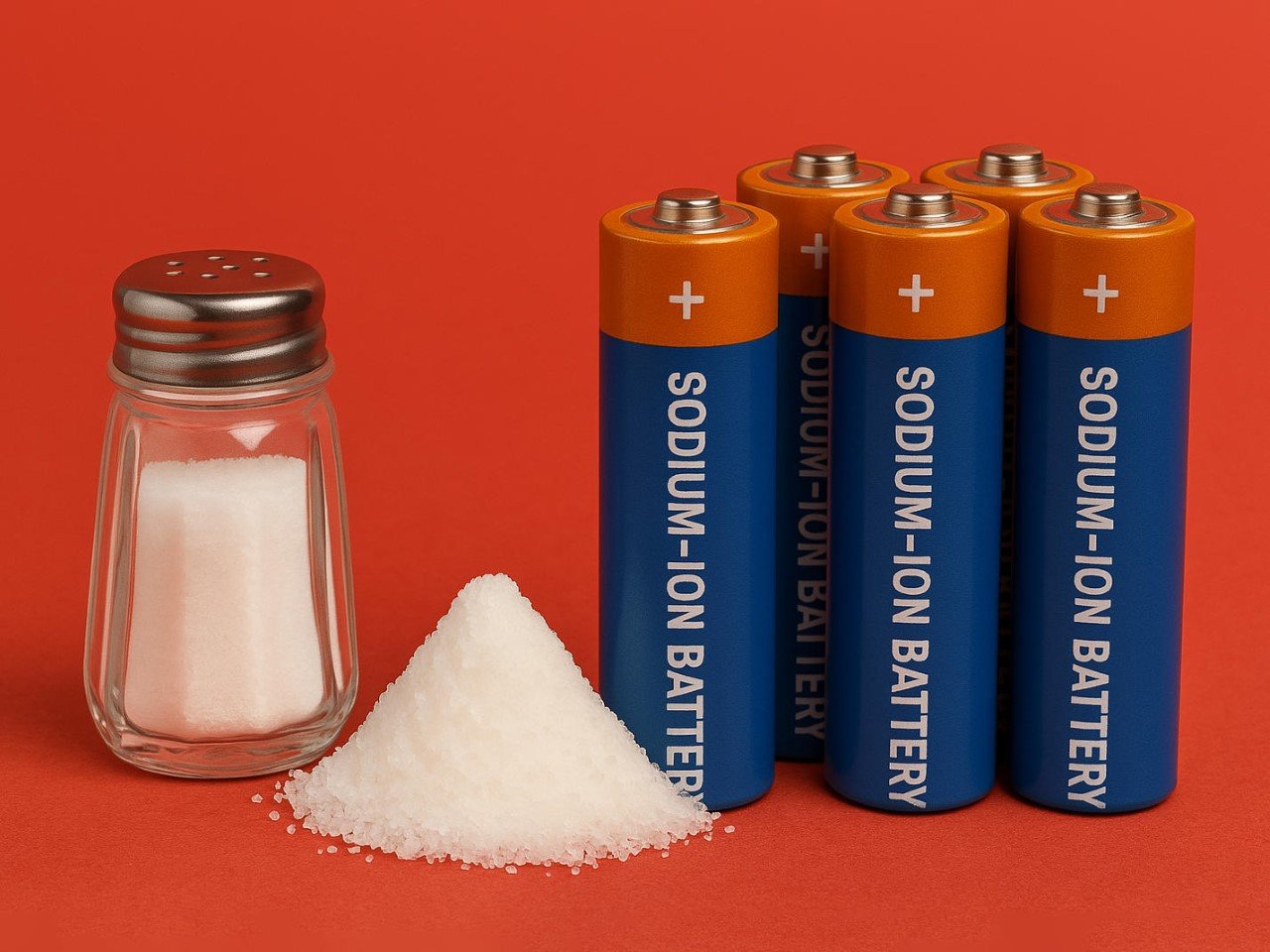
WWW.YANKODESIGN.COM
Your Next EV Could Be Powered By Salt – Why Sodium-Ion Batteries Are The ‘Next Big Thing’
What if the very salt you use to season your food is the same that powers your gadgets? Yes – it seems like Lithium’s time in the sun has ended as CATL – the behemoth that manufactures 40% of the world’s lithium batteries – plans on pivoting half its future business to sodium-ion technology. When the company that built an empire on lithium starts looking elsewhere, you know something big is happening.
Every person owns roughly a minimum of 5 objects that are powered by lithium-ion batteries. They’re in everything from your phone to your video doorbell to your earbuds to even your electric car. Lithium-based batteries literally power the world today, but there’s a fundamental problem with them – they’re unstable, fairly scarce, and difficult to acquire without completely ravaging the environment. That’s why the world’s largest battery maker is looking at the next best alternative – the same stuff you line your margarita glasses with. That’s right – salt, or as scientists call it, Sodium Chloride.
From Table Salt to Battery Powerhouse
Sodium sits one row below lithium on the periodic table – the overlooked middle child to lithium’s golden boy status. Both elements share a crucial trait: they readily surrender electrons, making them perfect battery materials. But sodium atoms are pudgier and heavier than their lithium counterparts, creating the technology’s Achilles’ heel: energy density.
Current sodium-ion batteries pack roughly 160-200 watt-hours per kilogram compared to lithium’s 300 Wh/kg. When it comes to building EVs, the disadvantages stack up pretty quickly, given how heavy existing EV batteries are. Swapping out Lithium for Sodium would make these batteries nearly twice as heavy, severely impacting the car’s overall weight and therefore, its range. Yet, despite this handicap, sodium is increasingly finding adoption in battery tech.
The reason becomes obvious when you look beyond the spec sheet. The Earth’s oceans hold approximately 180 billion tons of sodium – a supply so vast it makes “abundance” seem like an understatement. Lithium, meanwhile, exists primarily in remote salt flats and hard rock deposits, concentrated in geopolitically complex regions like the “Lithium Triangle” of South America and conflict-prone areas in Africa.
Extracting lithium demands intense water usage in often drought-stricken regions, creating environmental flashpoints and community tensions. Sodium, by contrast, can be sourced from seawater or common salt deposits through simpler, less resource-intensive processes. The environmental footprint difference is stark.
Cost also plays a significant role in this pivot. Salt is dirt cheap – actually, cheaper than dirt. While lithium prices have ridden a rollercoaster that threatened to derail EV adoption, sodium remains stable and abundant. BYD (Tesla’s most formidable global competitor) projects sodium batteries could eventually undercut lithium costs by 30-70%. For an industry where pennies per kilowatt-hour determine market winners, that’s not just an advantage – it’s potentially game-set-match.
The Great Salt Rush of 2025
CATL isn’t merely pontificating about sodium’s theoretical potential – they’ve already commercialized it. Their Freevoy battery pack combines lithium and sodium cells in a hybrid system for long-range EVs, threading the needle between sodium’s cost advantages and lithium’s energy density.
Their second-generation sodium battery, launching later this year, promises energy density exceeding 200 Wh/kg. While still trailing lithium, this represents a remarkable leap from the first generation’s 160 Wh/kg. The gap is closing faster than many expected.
BYD, meanwhile, is making an even bolder play. Their sodium-ion gigafactory under construction will churn out 30 gigawatt-hours of batteries annually when fully operational in 2027 – enough to power roughly 600,000 electric vehicles. For perspective, that’s more than the entire UK electric vehicle market in 2023.
The sodium rush extends beyond the Chinese giants. Zhejiang Hu Na Energy recently fired up a 4 GWh production line with plans to quintuple capacity. Across the Pacific, American startup Natron Energy is building a 24 GWh facility in North Carolina after establishing a beachhead factory in Michigan.
Sub-Zero Superstar: Why Winter Loves Sodium
Beyond cost and sustainability, sodium-ion batteries offer a performance advantage that anyone who’s driven an EV in Minnesota will appreciate: exceptional cold-weather resilience.
Lithium batteries and frigid temperatures mix about as well as cats and bathtubs. Below -20°C (-4°F), lithium ions struggle to intercalate properly into the anode, instead plating onto its surface. This “lithium plating” reduces capacity, damages the battery, and in extreme cases, creates safety hazards.
Sodium ions, with their larger size and different chemical properties, resist this plating effect. CATL claims its second-generation sodium batteries function reliably down to -40°C (-40°F) – the point where Fahrenheit and Celsius converge and conventional lithium batteries essentially give up.
For drivers in northern climates, this isn’t a minor technical distinction – it’s the difference between reaching your destination or calling a tow truck during winter months. For fleet operators, it means consistent range regardless of season.
Sodium batteries also demonstrate superior thermal stability at the other end of the thermometer. They’re less prone to thermal runaway – the battery equivalent of a chain reaction that can lead to fires. For grid storage installations in hot, fire-prone regions like Australia or California, this safety profile could prove decisive.
TAQ Team: The MIT Breakthrough Changing the Game
While commercial sodium batteries advance rapidly, researchers are attacking sodium’s energy density limitation from another angle. Scientists at MIT’s Dincă Lab have developed an organic cathode material called TAQ (bis-tetraaminobenzoquinone) that could fundamentally change the sodium battery equation.
Traditional cathodes rely on metals like cobalt and nickel that are scarce, expensive, and environmentally problematic to extract. TAQ replaces these with carbon, hydrogen, oxygen, and nitrogen – elements so abundant they form the backbone of life itself. The researchers claim performance rivaling cobalt-based cathodes at one-third the cost.
What makes this development particularly intriguing is its industrial backing. The initial research was funded by Lamborghini – not exactly a company known for investing in technologies without performance potential. When a manufacturer of 200 mph supercars takes interest in sodium batteries, it suggests the technology’s limitations might be more temporary than fundamental.
When Salt Gets in the Wound: Challenges Ahead
Despite the momentum, sodium-ion technology faces significant headwinds. The dramatic collapse of lithium prices – down 70% over the past three years due to production increases – has temporarily weakened the economic case for alternatives. The battery industry is notoriously cyclical, and sodium’s cost advantage looks less compelling when lithium is cheap.
Sodium battery manufacturers also remain too small to benefit from economies of scale, creating a classic chicken-and-egg dilemma. They need volume to drive down costs, but struggle to achieve volume without competitive costs. This challenge claimed a victim in Swedish manufacturer Northvolt, which unveiled a promising sodium battery in 2023 before filing for Chapter 11 bankruptcy protection.
The technology also faces entrenched interests. The lithium supply chain represents trillions in investments, from mines to processing facilities to battery factories. This industrial momentum creates resistance to change, even when the alternative offers compelling advantages.
The Sodium Stratification: Finding Each Chemistry’s Sweet Spot
The most likely future isn’t a wholesale replacement of lithium but strategic deployment of sodium in applications where its strengths matter most and its weaknesses least.
Grid-scale energy storage represents sodium’s most promising beachhead. When batteries are stationary, energy density becomes secondary to cost, safety, and longevity – all areas where sodium shines. As solar and wind deployment accelerates, the demand for affordable storage will explode, creating a natural market for sodium technology.
For electric vehicles, a segmented approach seems probable. Budget models and urban delivery vehicles could adopt sodium batteries first, leveraging their lower cost and excellent cold-weather performance without requiring the energy density of long-range vehicles. Premium cars might retain lithium for years longer, or adopt hybrid systems like CATL’s Freevoy that combine both chemistries.
This market segmentation parallels what we’ve seen with lithium batteries themselves. Different formulations – NMC, LFP, NCA – have found niches based on their particular strengths rather than a single chemistry dominating all applications.
Worth Its Salt: The Future of Sodium Power
Battery technology evolves through persistent iteration rather than dramatic breakthroughs. Sodium-ion batteries exemplify this pattern – they don’t render lithium obsolete but complement it by addressing specific weaknesses in our current energy storage ecosystem.
When the world’s largest battery manufacturers bet billions on a technology, I pay attention. CATL and BYD have built empires by recognizing inflection points before they become obvious. Their aggressive sodium expansion suggests they see a major shift coming – one that could reshape the energy storage landscape over the next decade.
For consumers, this transition promises more affordable electric vehicles that perform better in cold climates. For grid operators, it offers cheaper, safer energy storage solutions. For the planet, it represents a more sustainable path forward, reducing dependence on problematic mining operations and making clean energy more accessible globally.
The sodium revolution won’t happen overnight. Technological inertia, existing investments, and ongoing improvements to lithium batteries ensure a gradual transition. But the trajectory seems increasingly clear: that humble white crystal seasoning your food is poised to power our electrified future.
Next time you reach for the salt shaker, consider that you’re handling what might become the lifeblood of tomorrow’s energy systems. In a world obsessed with exotic materials and complex solutions, there’s something beautifully elegant about powering the future with one of Earth’s most common elements.The post Your Next EV Could Be Powered By Salt – Why Sodium-Ion Batteries Are The ‘Next Big Thing’ first appeared on Yanko Design.
0 Σχόλια
0 Μοιράστηκε
40 Views












